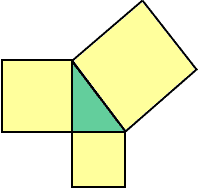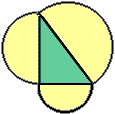Subject: pythegorean theorem research project
Hi my name is Mohammed. I am a math honors student in 8th grade. I have to do a research project in math. The only problem is that I have to do the research project at a 10th grade level. I am having trouble raising the project at a tenth grade level. Would you please kindly take your time to give me some tips and web sites that will help me raise the Pythagorean theorem to a 10th grade level. Would you please e-mail me back at Yanks21109.
Thank You for you time,
Mohammed
Hi Mohammed
I have a number of suggestions for you.
Frist from Jack
Try this.


Repeat for rectangles that have the height:base = 3:1.Repeat for 1:2, etc Now draw an equilateral triangle on each side and repeat. Try it for a hexagon. You may soon see that the secret has to do with the fact that the figures are similar (i.e. have the same shape).

Jack
Second from Walter
One way to raise the level would be to investigate what happens when the angle is NOT 90 degrees.
- If the angle is < 90, then a^2 + b^2 > c^2
- If the angle is > 90, then a^2 + b^2 < c^2.
- If the resulting angle is 90 - the area's are equal.
- If less than 90, the two medium are larger.
- If more than 90, the large is larger!
Here is a second direction. One use of pythagoris is as a CONSTRUCTION of a new square with the area of the sum of the areas of two smaller squares. Some people think that that was the Greek use of the theorem - to constructively add squares. Now look at how to change triangles into squares of the same area (constructively). With that, you can take any polygon, divide it into triangles, change them into squares and add them. The goal is to prove that ANY polygon can be constructively changed into a single square of the same area.
A consequences is that any two polygons of the same area can be cut up and reassembled into the same square (or one another) in a finite number of steps. This is called 'dissection' and 'equidecomposibility' in the geometry texts. In case you think this is obvious - tha analogous statement about objects in 3-space is WRONG!
Walter
And a footnoteote:
If you go to the Quandaries and Queries section of Math Central and search in the keyword field for Pythagoras you will find some questions and answers concerning Pythagoras. Three of them might be of interest.
- Presidental Proof:
There is a proof of the Theorem of Pythagoras that comes from an American president. Can you guess which president? - Triangles the Pythagorean Theorem and Pizzas
Dont read this until after you have "investigated the semi-circle drawn on the hypotenuse" as suggested by Jack - Euclid's Pythagorean Proof
The Centralizer